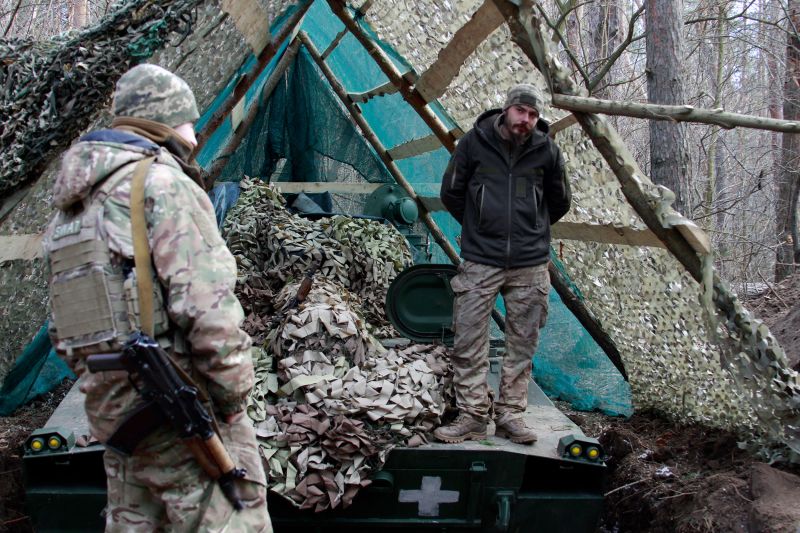As US Congress stalls on aid, Ukrainian soldiers head to the frontlines knowing they don’t have enough ammunition


Artem spends a lot of time thinking about the shots he can’t afford to take.
As a battery commander in the 26th Artillery Brigade of the Ukrainian military, he decides when his gunners fire and when they need to hold off.
Lately, it’s been a lot more of the latter.
“Last summer, we used 100 shells per day. The enemy infantry did not even think about moving here. They had no plans to advance because they knew that every unit that was here would use everything they had to repel their attack,” the 24-year-old, whose call sign is “Shaman,” said. He asked for his last name to not be published, for safety reasons.
These days, his men are forced to make do with a fraction of the amount of ammunition they used to have. That means they can only strike top priority targets, a limitation which is allowing Russian troops to slip through.
“In the past, if I saw their firing position, a dugout, machine guns… I would hit them. Now I don’t do that,” he said. “The priority is the tank, the gun – if it is firing, the multiple launch rocket systems. If I see infantry and no one gives me a command, then I don’t shoot, because we have to save the shells.”
It’s a scenario that’s playing out up and down the front lines in Ukraine. As the United States Congress stalls on US President Joe Biden’s request for an additional $60 billion in security assistance for Kyiv, Ukrainian commanders are facing tough choices on how to use the dwindling stockpiles of ammunition.
Kyiv suffered its most significant loss in recent months last week when its troops abandoned Avdiivka, a town that has been on the front lines since Russian-backed separatists seized control of parts of the eastern Donbas region in 2014.
It’s a blunt assessment, but one that international observers agree with. The Institute for the Study of War, a US-based think tank, said that delays in Western help, “namely artillery ammunition and critical air defense systems, inhibited Ukrainian troops from defending against Russian advances in Avdiivka.”
Oleh Kalashnikov, the spokesperson for the 26th Artillery Brigade, said that the change in supplies in recent months has been significant.
“When [the Russians] launch an assault and our infantry asks for artillery support, when it works well, the infantry immediately feels better and more secure because they know they are protected, because we simply cut off the enemy with the artillery fire,” he explained. “It has a psychological effect too.”
He said that, while the Ukrainian army had a clear advantage in the number of shells fired earlier in the war, that has gradually been lost, and it’s now Russia that has the clear edge on ammunition.
The Ukrainian military does not release exact numbers of artillery rounds it has available. Researchers, western and Ukrainian officials and others offer widely different estimates of Russian and Ukrainian fire. What is clear though is that Russia is firing multiple times as many rounds as Ukraine.
More injured, more killed
At a medical facility not far from the Bakhmut area front line, Dr. Sviatoslav Mykytiuk is also seeing the painful consequences of the ammunition shortages.
Mykytiuk is the surgeon of the 22nd Brigade’s medical company and has spent the past year stationed in the area. He said the nature of injuries he is dealing with has changed dramatically over that time.
“Because the weapons, their quantity and quality are changing. These are mainly (different types of) drones, long-range artillery and missiles,” he said.
Mykytiuk said more soldiers are getting injured on the front lines because Russian infantry can get within firing distance of Ukrainian troops more often.
Crucially, it is also taking a lot longer to bring the wounded to the medical point. When artillery cannot cover infantry, the troops must wait for a window of opportunity to evacuate casualties.
The standard goal in military medicine is to evacuate any casualties within the “golden hour” after injury to maximize the chances of survival and recovery.
In eastern Ukraine, Mykytiuk said, the evacuation can take up to a day, sometimes even longer.
This means Mykytiuk and his colleagues are seeing many more secondary injuries caused by the long delays. Soldiers get to him suffering with hypothermia and completely exhausted.
“It’s clear that our soldiers do not have enough of these modern weapons. Because we mostly use the remnants of the weapons that were left to us after the Soviet Union,” he said.
But the morale, he said, is still there.
He recalled a reconnaissance man who was hit in a drone attack when returning from a forward mission. With a deep wound across his shoulder and back, bleeding heavily, he walked some six kilometers (four miles) to get back to his unit.
Hours later, when he finally made it to the medical point, he explained what happened and said he was wounded, the doctor said.
“Then he asked: ‘Am I with the medics now?’ We said: ‘Yes, this is a stabilization point, doctors are working here, you are here.’ And then he said: ‘May I shut down now?’” Mykytiuk said.
“We paused, we didn’t understand what had happened, and we said ‘yes.’ He just collapsed. The amount of strength and concentration it took to walk six kilometers on foot, to get to the stabilization point, to make sure you were there, and then to just fall down from fatigue. He realized that he was in good hands, that he would be helped here. Spirit does exist,” Mykytiuk said.
That horrible feeling
Fighting the Russians around Bakhmut, Oleh Bulatetskyi, an artillery troop commander with the 30th Brigade, knows he needs to make every shot count. The troops on the front lines, including people he and his men know personally, are relying on him for protection.
His unit is using Soviet-era 2S1 Gvozdika howitzers. Developed in the 1970s in Kharkiv, not far from where he is now, these artillery pieces are a lot older than most of his men. They are reliable and easy to move around, but they lack precision compared to more modern Western weapons.
Lack of accuracy is not an insurmountable problem – one way to get around it is to fire as many rounds as possible to maximize the impact. But that strategy is no longer an option in Ukraine.
“We have had major problems with shortages during the Bakhmut and Soledar operation… now we must find different ways to make it work. At the moment, drones are helping us cope with this,” he said.
The Gvozdika howitzer that Bulatetskyi and his men use is a bit rusty and the ceiling of the narrow shaft that leads into the main compartment where the gunner and loader operate is covered with tiny icicles.
The platoon’s gunner, Artem, says that he would love to be able to fight the Russians with modern NATO weapons too. But the Gvozdikas are well-made machines and, with sufficient supplies, they can do the job, he said.
A 27-year-old whose call sign is “Sailor,” Artem sports a big beard and moves around the tight space inside the massive weapon with the confidence of someone who has been doing it for years. He spends weeks and months at a time staying in freezing dugouts, ready to launch at any moment. He has also asked for his last name to remain private.
Yet sitting in his seat inside the heart of the machine, Artem talks about the horrible feeling of not having enough ammunition.
“One time, I was firing, and it turned out that at that time, I was covering my nephew’s (infantry) unit. We fired very few shells there, I think, and there were lot of wounded,” he said. “We held the place, but there could have been fewer losses or maybe the injuries wouldn’t have been so severe (if we had more),” he said.
His nephew was injured in the battle and nearly lost an arm.
“If he was thinner, he would have lost it,” he said. “But he is ok now, fighting again.”
Nowhere is the toll of the ammunition shortage more evident than at the Kharkiv City Cemetery, where an entire new section is dedicated to recently fallen soldiers. There are hundreds of graves, each flying a large Ukrainian flag. The sound they make in the wind is overwhelming.
Most of the graves are new, many of them just a few weeks or even days old. “They say that we are stopping the Russian evil from spreading across the world at the expense of human lives, while Europe and America are only spending money. That’s a pretty good deal,” Kalashnikov said.











